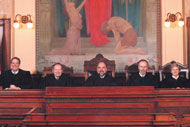7/22/2008
South Dakota Supreme Court: City Not Liable for Dangerous StreetSouth Dakota Supreme Court rules that cities cannot be held liable for maintaining unsafe roads.

The South Dakota Supreme Court ruled Wednesday that cities could not be held liable for failing to address known safety hazards on local streets. Because this conclusion overturns precedents set over a number of decades, the court allowed one last $3.85 million judgment against a negligent city to stand with the understanding that no such awards would be permitted in the future.
A jury had found that Rapid City should pay that multimillion dollar sum because it failed to post warning signs or install a guardrail near a canal at Canyon Lake Park that had been the site of six nearly identical accidents in seven years. One of the most serious of these occurred on December 27, 2000 at around 9pm. Charissa Hitchcock, then 16, was driving the snow-covered street with Adam Hohm, also 16, and a third passenger. As Hitchcock's Honda reached the curve, it slid off the road and landed upside down in the icy water. Hitchcock and the third passenger were quickly rescued, but Hohm remained trapped underwater for several minutes. Hohm suffered permanent brain damage as a result of oxygen deprivation.
Hohm's parents sued the city claiming negligence. Rapid City countered that it "owed no duty to Adam." After evaluating both sides of the argument, a trial court found that Rapid City had neglected its common law duty to maintain safe streets. On appeal, the state supreme court concluded that the trial court had interpreted precedents correctly, but that those precedents would now be thrown out for all future cases.
"Under our prior cases, we conclude that the trial court did not err in determining that the city had a common-law duty to safely maintain its streets," Justice Steven L. Zinter wrote for the court. "Even if we were to determine that some vestige of the common-law liability of municipalities survived... we hold that it was fully abrogated by the 1939 statutory revisions that eliminated the broad duty to maintain reasonably safe highways and confined counties and townships, as well as cities and towns, to the more limited duty to guard and repair highways that are damaged or destroyed."
In June, the Ohio Supreme Court came to a similar conclusion in a case absolving local governments from liability for negligence (view opinion).
"This is a sharp change in direction," Justice John K. Konencamp explained in a concurring opinion. "Almost from the time of statehood, cities have been liable under the common law for negligence in failing to maintain streets in a reasonably safe condition for the traveling public."
Justice Konencamp went on to explain the court's primary motivation for making this change was financial.
"As society became more mobile in the last century, with the increasing role motor vehicles played in every facet of American life, government officials struggled with ways to contain the costs of building and maintaining safe roads."
A copy of the opinion is available in a 190k PDF file at the source link below.


